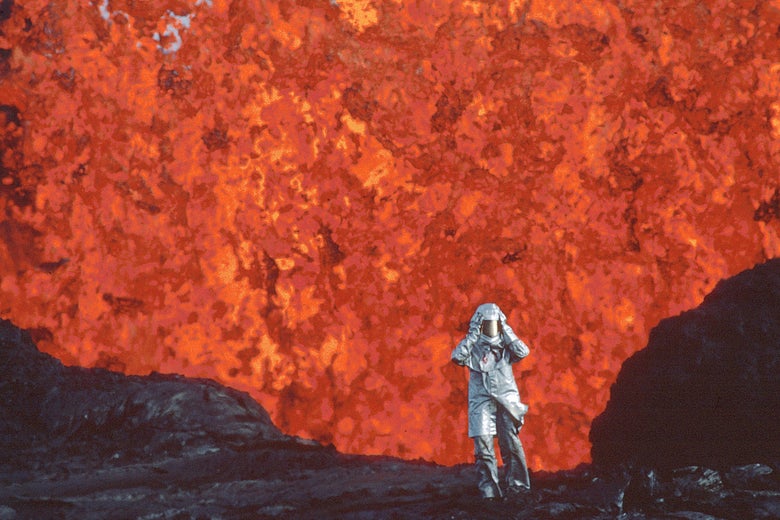When we first see Katia and Maurice Krafft, they’re just a distant speck, the unseen occupants of a jeep trundling through foot-deep snow that stretches as far as the eye, or the camera, can see. Throughout the course of Sara Dosa’s thrilling, moving documentary Fire of Love, which is now in theaters, we will come to associate the pair of married volcanologists more with heat than cold, especially the erupting plumes of deep-orange lava they risked—and eventually gave—their lives to capture. But at the outset it’s as if they’re being taken out of a deep freeze, revived by the footage in which they have lain dormant for decades.
Fire of Love bills itself as a movie “from the deep archives” of the Kraffts, and it’s primarily drawn from over 200 hours of their footage, interspersed with a handful of TV interviews that document their side gigs—particularly Maurice’s—as genial talk-show personalities. Towards the beginning, Maurice jokes during a joint interview in their shared workspace that there are few relationships between volcanologists, because their romances tend to be “volcanic.” The adjective seems less indicative of their marriage than the way Katia plays along with the joke, holding steady in the background of the show as if she hasn’t heard it a million times before.
The product of a shared obsession that consumed and eventually ended their lives—as Miranda July’s narration informs us early on, the Kraffts were killed attempting to document the eruption of Japan’s Mount Unzen in 1991—Katia and Maurice come off at times like characters in a Werner Herzog documentary, which they have been, briefly featured in his 2016’s Into the Inferno and as the subjects of Herzog’s The Fire Within: Requiem for Katia and Maurice Krafft, which had its festival premiere late last month. (Dosa’s debuted at Sundance in January.) But Fire of Love puts its emphasis on the “shared” as much as the obsession, the love more than the fire.
The Kraffts aren’t alive to speak for themselves, and Dosa and her editors Erin Casper and Jocelyne Chaput deal delicately with the intimations of intimacy they coax from the footage. (All three share writing credit with Shane Boris.) Miranda July’s narration occupies a place of possibility rather than proclamation, and the text she’s reading pokes at the holes in the historical record—the unknown story of how Katia and Maurice first met, or the lack of photos from their early days of their relationship—rather than papering them over. (The movie doesn’t foreground it, but because their original footage was usually silent, nearly every sound in the movie was recreated.) A marriage can be as mysterious as a volcano, and the movie doesn’t pretend to understand its workings so much as observe its effects. Like the Maysles’ brothers documentaries about Christo and Jean-Claude, which followed the environmental artists and life partners over the course of several decades, Dosa’s movie makes the case that their private bond is inextricable from their public work, and it’s a toss-up as to which is the greater monument.
That work makes up most of Fire of Love, footage of active volcanoes that is often staggeringly beautiful (and is one reason why the movie is worth seeing in a theater, rather than waiting for its release on Disney+ later this year). The glow of molten orange against black rock captured on celluloid is one of the great uses of the medium, and it has often driven filmmakers towards poetic abstraction—Herzog’s La Soufrière and Vittorio de Seta’s Islands of Fire being two of the most splendid examples. But as much as the volcanoes’ terrifying beauty brought the Kraffts together—the narration says they initially bonded over their mutual love of Mt. Etna—Katia and Maurice were aimed at a greater purpose, especially towards the end. There was something of the aesthete and the adventurer in both of them—Maurice especially tended towards the latter, at one point taking a rubber raft out on a lake of sulfuric acid while Katia smartly stays behind—but the travelogues they produced (Maurice’s short documentaries, Katia’s photo books) subsidized a scientific study bent on predicting eruptions, especially those of the mercurial, explosive gray volcanoes that spew ash as well as fire. One longtime colleague of theirs is caught in the blast at Mount St. Helens in 1980, leaving behind only a melted wad of cassette tapes.
The ending of Fire of Love might have seemed inevitable even if it weren’t announced at the start—in the battle of human vs. volcano, there can only be one winner. But even the best love stories end in death. And now that we all create our own ever-growing archives, we can only hope that someday someone sifts through them with as much care, and retrieves something this profound.
